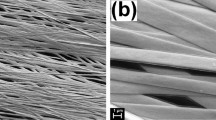Abstract
A novel rhombus-shaped electrochemomechanical unit constituted by 4 polypyrrole bilayer (conducting polymer/tape) muscles and two plastic hinges, able to transform reversible angular movements from the basic bilayers into longitudinal movements, has been successfully constructed and electrochemically characterized. During operation two of the bilayers act as anode and the other two as cathode. Thus, all the electrical energy is used, avoiding an additional metallic counterelectrode and the subsequent generation of products able to degrade the muscle. The reference electrode is short-circuited to the counterelectrode in order to monitor the muscle potential along the galvanostatic experiments and the sensing abilities of the device. The devices were checked by repetitive galvanostatic contraction/extension of up to 20% of the original length. About 50% of the devices produced irregular movements, due to different ohmic resistances in the electrical contacts between the wires and polymeric films. Once the contacts were improved, the new devices showed good reproducibility. The influence of electrolyte concentration, experimental current and weight trailed by the device indicates that the complex device maintains most of the sensing properties of the basic bilayer muscles. Then checking the life-time of the device, contact failures and fissures around the metal/polymer joint were immediately detected from the chronopotentiometric noises which appeared after several cycles. Such failures must be solved before the device can be miniaturized and in order to construct different shapes, and three-dimensional sensing muscles for robotics from combinations of basic units.
Similar content being viewed by others
References
Otero T.F., Angulo E., Rodríguez J. and Santamaria C.J., (1992). J. Electroanal. Chem. 341: 369
Pei Q. and Inganas O., (1992). Adv. Mat. 4: 277
Baughman R.H., (1991). Makromolekulare Chemie-Macromolecular Symposia 51: 193
R.H. Baughman, L.W. Shacklette, R.L. Elsenbaumer, E. Plitchta and C. Becht, in J.L. Brédas and R.R. Chance (Eds.), Opportunities in Electronics, Optoelectronics and Molecular Electronics, (Kuwler Acad. Pub. Netherlands 1990), pp. 559–582.
D. DeRossi, Research and Development 67, (1989)
Burgmayer P. and Murray R.W., (1982). J. Am. Chem. Soc. 104: 6139
Françoise B., Mermilliod N. and Zuppiroli L., (1981). Synth. Met. 4: 131
Okabayashi K., Goto F., Abe K. and Yoshida T., (1987). Synth. Met. 18: 365
Slama M. and Tanguy J., (1989). Synth. Met. 28: 171
Smela E., (2003). Adv. Mat. 15: 481
Cortés M.T. and Moreno J.C., (2003). e-Polymers 42: 1
Otero T.F. and Cortés M.T., (2003). Adv. Mat. 15: 279
Otero T.F. and Cortés M.T., (2003). Sensors and Actuators B: Chemical. 96: 152
Baughman R.H., (1996). Synth Met. 78: 339
Jager E.W.H. , Inganas O. and Lundstrom I., (2000). Science 288: 2335
Jager E.W.H., Smela E. and Inganas O., (2000). Science 290: 1540
Cortés M.T., (2002). Músculos Artificiales de Tricapa: caracterización y diseño de dispositivos, Doctoral Theses. University of the Basque Country, Donostia, Spain
T.F. Otero, Handbook of Organic Conductive Molecules and Polymers: Vol. 4. Conductive Polymers, 1997 John Wiley & sons Ltd
Otero T.F. and Sansiñena J.M., (1998). Adv. Mat. 10: 491
Otero T.F. and Sansiñena J.M., (1997). Bioelectrochemistry and Bioenergetics 42:117
Otero T.F., Rodríguez J., Angulo E. and Santamaría C., (1993). Synth. Met. 55–57: 3713
T.F. Otero et al., Spanish patents EP-9200095 and EP-9202628
Acknowledgements
The authors acknowledge the support of the Spanish Ministry of Science and Technology, project BQ2001–0477, and of the Seneca Foundation PI-25/00827/FS/01. M. Broschart thanks G. Vázquez for her preparative studies, technical assistance and advisory activities in the matters related to this subject.
Author information
Authors and Affiliations
Corresponding author
Rights and permissions
About this article
Cite this article
Otero, T., Broschart, M. Polypyrrole artificial muscles: a new rhombic element. Construction and␣electrochemomechanical characterization. J Appl Electrochem 36, 205–214 (2006). https://doi.org/10.1007/s10800-005-9048-0
Received:
Accepted:
Published:
Issue Date:
DOI: https://doi.org/10.1007/s10800-005-9048-0




